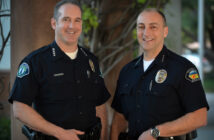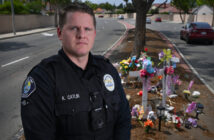On a recent Friday afternoon in Anaheim, some fans got an early start to an evening baseball game by holding a barbecue tailgate party in the shadows of the “Big A” sign and electronic marquee.
On the other side of a chain-link fence, only 50 or so yards away, a handful of Orange County Sheriff’s Department deputies slowly made their way through the Santa Ana Riverbed homeless encampment, a mini-city of makeshift homes constructed from tents, plywood, tarp and various other materials.
Two deputies, Sgt. Mike Starnes and Deputy Mike Harris, approached a tent.
“Sheriff’s Department, hello,” Starnes announced. “Anyone home?”
A man who identified himself as James came out.
“Hi, you need any help?” Starnes asked him.
“I need so much help it’s not even funny, bro,” James replied.

Lacey Piercy, who has been homeless for about a year, holds one of her cats, Spirit. “She adopted me,” Piercy said. She says she became homeless as a result of medical bills from her husband’s heart transplant.
Photo by Steven Georges/Behind the Badge OC
But James didn’t feel like talking to the deputies on this day, Sept. 15, when the OCSD began regular patrols of the Santa Ana River homeless encampments, where some 400-plus people live in the most concentrated section around Angel Stadium.
The riverbed encampments, which include the cities of Orange and Santa Ana and stretch southwest to Fountain Valley, have spurred the city of Anaheim to declare a state of emergency as city and county officials seek a new 500-person emergency shelter, as well as ways to make it easier for more shelters to be built so the riverbed trails can be cleared.
And with criminal activity and drug use regularly occurring along the riverbed, where filthy living conditions have raised health concerns, the OCSD has taken the lead on a law enforcement task force that targets crime and also makes sure people know about the resources that are available to them.
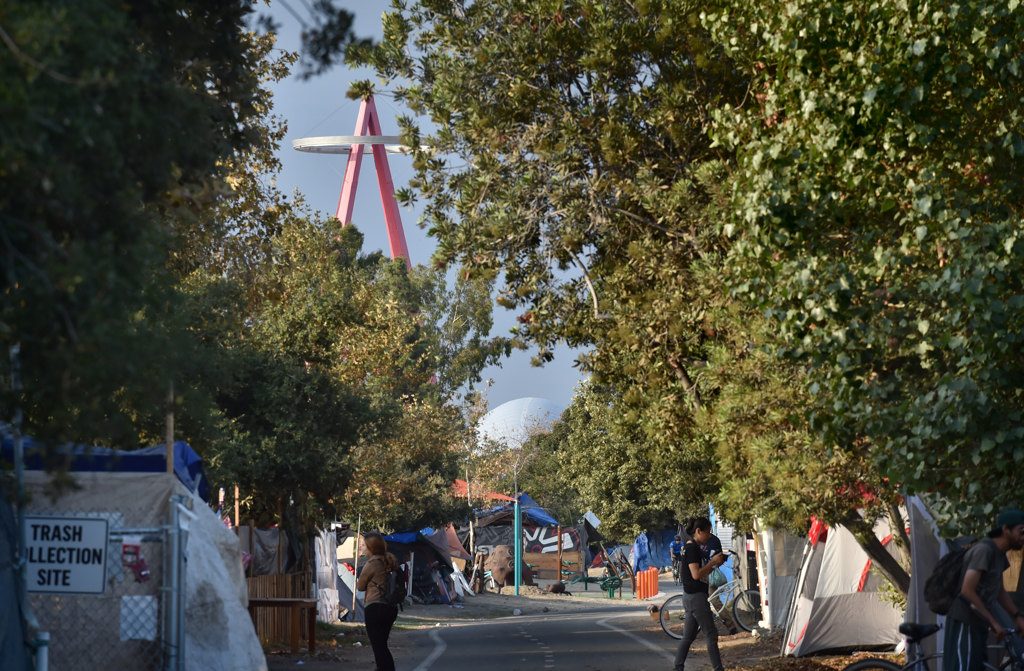
The homeless camp along the Santa Ana River bike path near Angel Stadium.
Photo by Steven Georges/Behind the Badge OC
The deputies, along with officers from Anaheim, Orange Fountain Valley and Santa Ana, aren’t attempting to remove people from the riverbed, but they are focusing on eliminating a criminal element that plagues the area.
“It’s a delicate balance that we have to figure out,” said OCSD Sgt. Shannon Parker, a sergeant on the OCSD’s HOT (Homeless Outreach Team). “This isn’t just a law enforcement issue. It’s a societal issue.”
HOT was established a year ago, before the Santa Ana Riverbed homeless encampments blew up into a major problem, with complaints from adjacent businesses and residences a daily issue.

OCSD Deputy Mike Harris looks for people living in tents to check on their well being and to see if they want to take advantage of services being offered to the homeless.
Photo by Steven Georges/Behind the Badge OC
The upscale Renaissance at Uptown Orange, a Tuscan-style community of condominium-like homes, where a one-bedroom, one-bathroom unit will set you back nearly $2,000 a month, is separated from the encampments by a 7-foot-tall, wrought-iron gate. Residents, some of whose carports are only feet away from tents, regularly complain about vandalism and other crimes.
HOT, which has grown to two sergeants and four deputies, was formed to work with Orange County Public Works and the County Health Care Agency to aid the homeless.
Starting Sept. 15, the unit is being reinforced with a dozen or so extra deputies, along with officers from the Orange, Anaheim, Fountain Valley and Santa Ana police departments, to patrol the encampments on Fridays and Saturdays — days considered prime time for criminal activity.

OCSD Deputy Mike Harris talks to William Schieberl, a veteran who is now homeless, to collect information about him and see if he wants to be directed to any resources. Not everyone was willing to talk to the deputies.
Photo by Steven Georges/Behind the Badge OC
In a statement, Undersheriff Don Barnes said the aim of the regular riverbed patrols is to protect the rights and civil liberties of everyone the OCSD serves.
“Being homeless is not illegal,” Barnes said. “We must recognize, however, that the flood control channels clearly are not intended for permanent residence, and the encampments create a significant problem for both the homeless and surrounding communities. In taking this approach, we hope to reduce the size of the encampments and mitigate the harmful impacts they can have.”
Since July, following a vote by the County Board of Supervisors to provide intensive case management services to the individuals encamped along the flood control channel, the county has been working with the nonprofit CityNet.

A container for used needles is tied to one of a number of trash collection sites set up along the homeless camps at the Santa Ana River. Orange trash bags are handed out in an effort to keep the area clean.
Photo by Steven Georges/Behind the Badge OC
Since then, more than 60 people have exited the flood-control channel through connections to alternate housing or shelter, county spokesperson Carrie Braun said. Additionally, more than 50 individuals are currently receiving case management from CityNet to connect to the services that best meet their needs, Braun said.
The county now subcontracts with Showers of Blessings through CityNet to provide showers three times per week to individuals encamped along the flood-control channel.
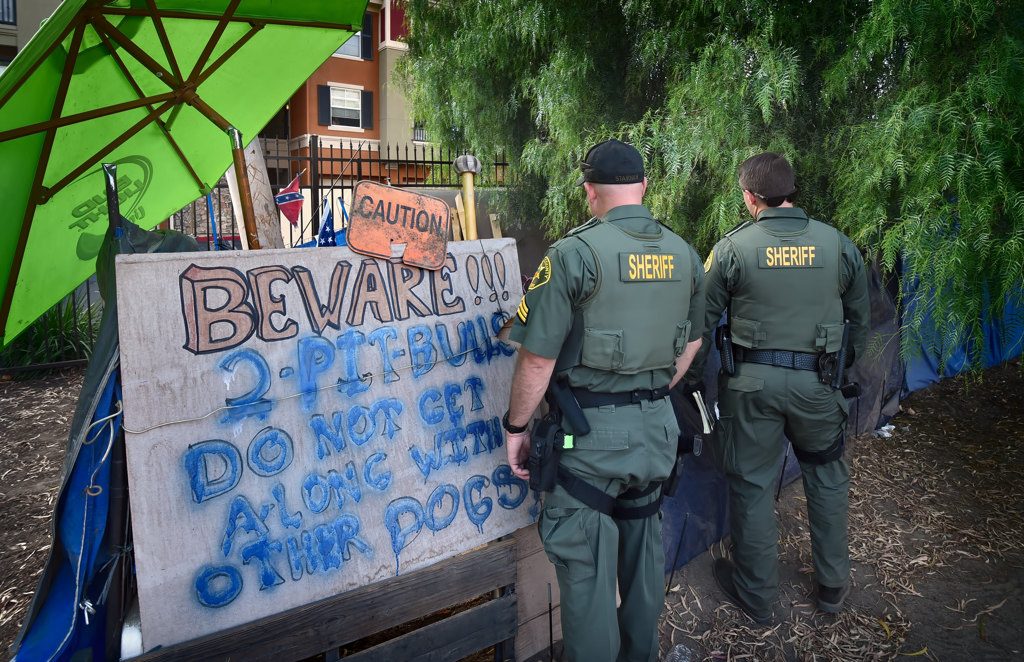
OCSD Deputies Sgt. Mike Starnes, left, and Mike Harris talk to a homeless woman camped along the Santa Ana River to see if she wants any help.
Photo by Steven Georges/Behind the Badge OC
Through Sept 27, the new HOT task force Friday and Saturday patrols had yielded 14 arrests and two citations.
Parker said there have many serious crimes being committed along the riverbed since the homeless population has grown, including petty thefts, assaults, robberies, assault with a deadly weapon and attempted murder.
In recent weeks, Orange police investigated a stabbing along the riverbed involving a homeless suspect, and Santa Ana police investigated a shooting in which the victim suffered non-life threatening injuries.
Throughout the encampments, booze and drug use is rampant.

Homeless people camped just on the other side of the fence at the “Big A” sign along the Santa Ana River.
Photo by Steven Georges/Behind the Badge OC
In many sections of the riverbed, hypodermic needles litter the ground, despite small red containers that have been made available throughout the encampments to dispose of the needles, which are used by heroin users.
The exact number of people living in the encampments is difficult to determine, since many people are away during the day and some avoid deputies when they patrol the riverbed at night, Parker said.
In a July survey, CityNet pegged the number at nearly 425 — just for those living between the most crowded section, between Chapman Avenue and Ball Road.
Deputies are attempting to gather information on riverbed occupants and follow up with them to make sure they are getting the resources they need.
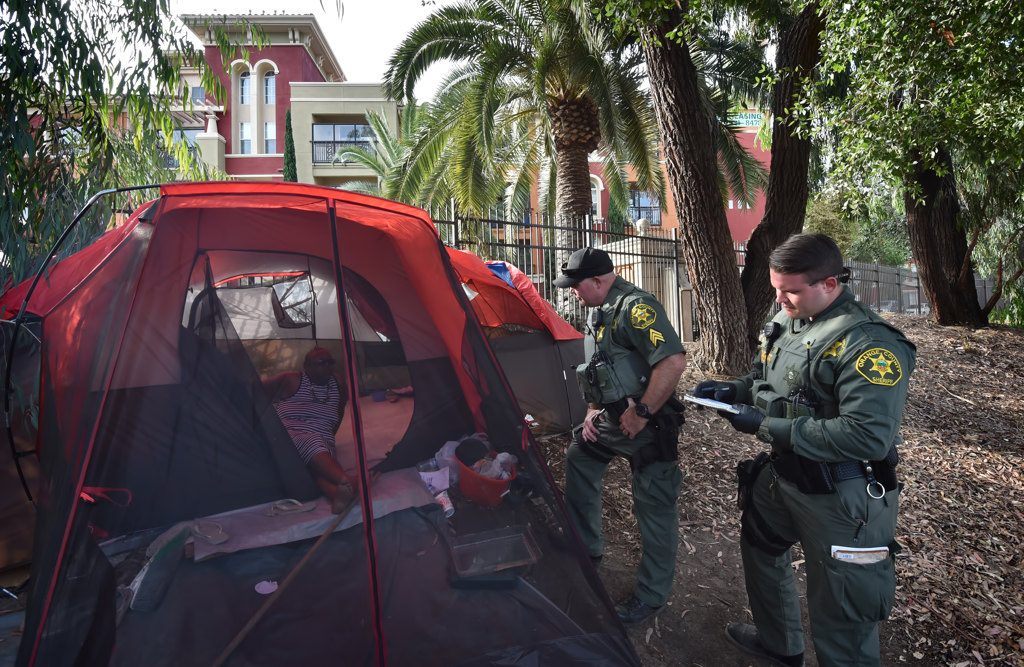
OCSD Deputies Sgt. Mike Starnes and Mike Harris, right, talk to a woman living in a tent along the Santa Ana River to see if she wants any services offered to the homeless.
Photo by Steven Georges/Behind the Badge OC
On Sept. 15, a total of 12 deputies and two OCSD sergeants walked the encampments. An APD officer joined them in patrolling what Parker described as a “whole world within a world, with its own set of rules.”
The pungent smell of urine and perspiration — of unwashed humans and pets, mostly dogs — is prominent in some sections.
Some occupants have makeshift doorbells outside their dwellings.
Some have barbecues and electric generators.
One person made a wooden entry gate.
In one tree, a mannequin’s head hung.

OCSD Deputies Sgt. Mike Starnes, left, and Mike Harris talk to “Victor” as deputies walk along the homeless camps. Some are willing to talk and some are not.
Photo by Steven Georges/Behind the Badge OC
There was a boxing bag hanging from another limb, a wind chime from another.
And bicycles are everywhere.
By 6:30 p.m. Sept. 15, deputies had made three arrests: one person had an outstanding warrant, and the other two were in violation of parole or probation.
They also issued several citations for possession of methamphetamine and heroin.
Starnes and Harris, supplied with OC Health Care Agency Behavioral Health Services OCLinks cards that list several phone numbers for people struggling with homelessness, mental health, and/or substance abuse problems, walked up to a middle-aged woman in a tent.
She was unable to stand because of back problems.
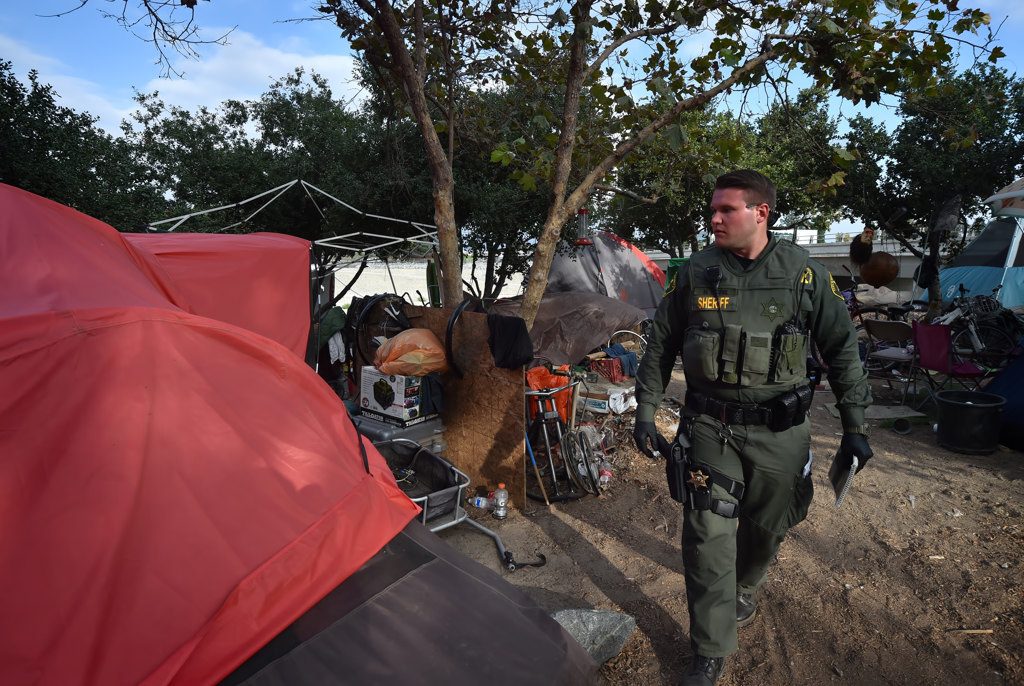
OCSD Deputy Mike Harris looks for people living in tents to check on their well being and to see if they want to take advantage of services being offered to the homeless.
Photo by Steven Georges/Behind the Badge OC
“Some things didn’t work out,” she said of why she’s been living along the riverbed for about a month.
“Do you know that across the street they are giving out supplies — food, clothing and such?” one of the deputies asked her.
“I didn’t know.”
The deputies told her they would get some people to bring her food.
In another tent, Fernie Sanchez, 45, of Orange, sat in a folding chair. He appeared to have not showered for several days.
“Any history of medical or mental problems?” a deputy asked him.
No, Sanchez said.
He told the deputies he was interested in finding housing.

Lacey Piercy, who has been homeless for about a year, holds one of her cats, Spirit. Photo by Steven Georges/Behind the Badge OC
“All right, Fernie, is there anything else we can do for you?” a deputy asked.
“No thanks.”
“It was good talking to you. Thanks for talking to us.”
In a brief interview, Sanchez said the law enforcement presence in a “nice change.”
He said he’s been homeless for four years.
“I could work,” said Sanchez, whose past jobs include restaurant server and warehouse worked. “I have a work ethic.”
He blamed the lack of showers for hurting his job chances.
Near him on the ground were used needles and a half-empty bottle of booze.
“When we approach the folks out there, we’re professional and honest with them,” Parker said. “We tell them why we’re out here. Obviously, we look around and take notes on what we see. We treat them with respect.”
He added: “The overwhelming majority of them appreciate us being out here.”

Resources being offered to the homeless at Chapman Avenue and the Santa Ana River.
Photo by Steven Georges/Behind the Badge OC
Parker said that based on his observations, there are four groups of people living along the riverbed: the chronically homeless, the mentally ill, criminals who no longer are in jail, and young adults with no motivation to work.
In May 2017, the county opened the first phase of its Bridges at Kraemer Place, a multi-service center in Anaheim for those experiencing homelessness that features a health clinic and provides bed space and services for up to 100 single men and women.
The facility ultimately will provide year-round shelter and services to 200 when phase two is completed in summer 2018.
Meanwhile, HOT will continually re-evaluate its efforts and adjust to work toward its ultimate goal: transitioning the homeless out of the riverbed.
Until then, Parker said, it’s “baby steps. We’re getting there, one step at a time.”
 Behind the Badge
Behind the Badge

